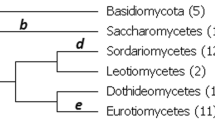Abstract.
Using the sequence information from nine completely sequenced bacterial genomes, we extract 32 protein families that are thought to contain orthologous proteins from each genome. The alignments of these 32 families are used to construct a phylogeny with the neighbor-joining algorithm. This tree has several topological features that are different from the conventional phylogeny, yet it is highly reliable according to its bootstrap values. Upon closer study of the individual families used, it is clear that the strong phylogenetic signal comes from three families, at least two of which are good candidates for horizontal transfer. The tree from the remaining 29 families consists almost entirely of noise at the level of bacterial phylum divisions, indicating that, even with large amounts of data, it may not be possible to reconstruct the prokaryote phylogeny using standard sequence-based methods.
Similar content being viewed by others
Author information
Authors and Affiliations
Additional information
Received: 22 November 1998 / Accepted: 17 February 1999
Rights and permissions
About this article
Cite this article
Teichmann, S., Mitchison, G. Is There a Phylogenetic Signal in Prokaryote Proteins?. J Mol Evol 49, 98–107 (1999). https://doi.org/10.1007/PL00006538
Issue Date:
DOI: https://doi.org/10.1007/PL00006538




